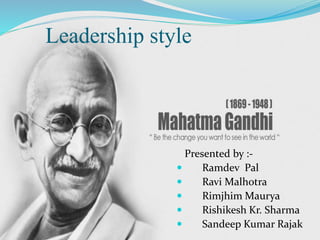
leadership style
- 1. Leadership style Presented by :- Ramdev Pal Ravi Malhotra Rimjhim Maurya Rishikesh Kr. Sharma Sandeep Kumar Rajak
- 2. oThey are the patterns of behavior which a leader adopts in influencing the behavior of his followers. oIt is the manner of providing direction, implementing plans and motivating people.
- 3. BEHAVIORAL LEADERSHIP STYLE…. In this leadership style, the leader gives more emphasis on his behavior rather than traits for providing leadership. His effectiveness is determined primarily by his specific behavior.
- 4. In this style, the leader adjusts his style to fit with the followers and the situation. His success is determined by his effectiveness to deal with situations based on his traits.
- 5. TYPES OF LEADERSHIP STYLE Based on behavioral approach :- 1. Power orientation 2. Leadership as a continuum 3. Employee - production orientation 4. Likert’s management system 5. Managerial grid 6. Tri- dimensional grid
- 6. BASED ON SITUATIONAL APPROACH Fiedler’s contingency model Hersey and Blanchard’s situational model Path goal model
- 7. POWER ORIENTATION This approach is based on the degree of authority which a leader uses in influencing the behavior of his subordinates. They are of three types:- Autocratic Participative Free- rein
- 8. AUTOCRATIC LEADERSHIP Strict Autocrat Benevolent Autocrat Incompetent Autocrat
- 9. Leadership as Continuum They are in fact a variety of styles of leadership behavior between two extremes of autocratic and free rein. Autocratic Free- rein Use of authority by the manager Area of freedom by the subordinates Boss-centered Employee-centered
- 10. EMPLOYEE- PRODUCTION MODEL The employee orientation stresses the relationship aspects of employee jobs. It emphasizes that every individual is important. The production orientation emphasizes production and technical aspects of jobs and employees are taken as tools for accomplishing the jobs.
- 11. System 1 : Exploitative Democratic- The leaders are highly autocratic and they take decisions unilaterally. They have no confidence on their subordinates and have no confidence on there subordinates System 2: Benevolent Autocratic- The leaders are autocratic but not highly autocratic. They sometimes consult there subordinates and have some confidence in them but keep strict control over them. LICKERT’S 4 SYSTEM OF MANAGEMENT
- 12. System 3: Consultative • The leaders consult their subordinates before taking final decisions and also believe in delegating some authority to them. System 4: Democratic • The leaders discuss the issues with their subordinates and decisions are taken by consensus.
- 13. Tridimensional Grid Reddin develoved a three dimensional grid , also known as 3-D management borrowing some of the ideas from managerial grid. Three dimensions represent task orientation, relationship orientation and effectiveness
- 14. Managerial Grid This style develoved by Blake & Mouton is based on two dimensional view of leadership style. They proposed “concern for people” and “concern for production” as the two dimensions They given a model in the form of grid which has been formulated on two 9 point scales as depicted in the following diagram and have identified five leadership styles. 1.9 9.9 5.5 1.1 9.1 Concern for people Concern for production
- 15. 1,9- Low concern for production and high concern for people 9,9- High concern for both people and production 5,5- Moderate concern for both people and production 9,1- High concern for production and low concern for people 1,1- Low concern for both production and people
- 16. In this approach there are four basic styles resulting into 8 styles these eight styles result from 8 possible combination of task orientation , relationship orientation and effectiveness as shown in figure below Basic style Less effective style More effective style Integrated Compromiser Executive Dedicated Autocrat Benevolent Autocrat Related Missionary Developer Separated Deserter Bureaucrat
- 17. Fiedler’s contingency model These model proposes that effectiveness of the leadership depends on attaining a proper match between the leadership style and situational variables. Leadership styles may be task –oriented (job oriented) or relationship oriented (employee oriented) The situational variables may be leader member relations , task structure and position power.
- 18. Hersey-Blanchard model According to this model effective leadership is dependent on obtaining a match between leadership style and level of maturity of followers, i.e. , leadership style should vary to match the subordinates maturity level. The model has three variables- Task behavior , relationship behavior and maturity.
- 19. Path goal model As per this model the role of the leader is to clearly show the path to the subordinates through proper direction. The leader define and explain the organizational goals to the subordinates and try to remove the barriers in their path achievement. A leader may choose any of these four styles – directive , supportive, participative or achievement oriented.
- 20. CONCLUSION No leadership style is best. Different situation demands different leadership style. A leadership is affected by- Type of organization (size, structure etc) Leader’s experience Confidence in subordinates Nature of business problems Subordinate’s skill and competency Employee’s trust in manager Nature of task (cooperative, directive etc)
- 21. REFERENCES Book: Principles and practice of management by L.M. Prasad Book: Human resource management by Shashi K. Gupta Book: Human resource management by C.B. Gupta Link: http://study.com/academy/lesson
